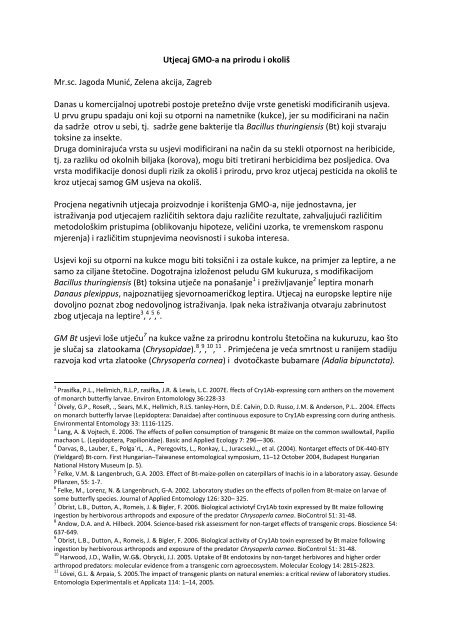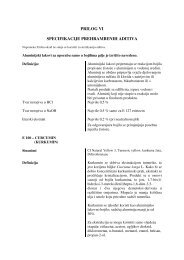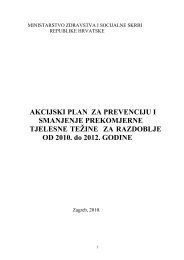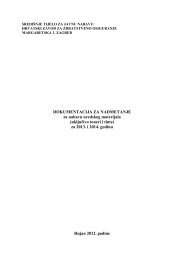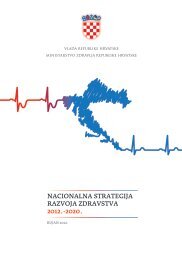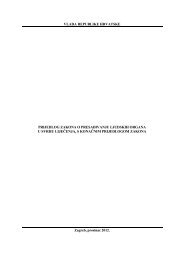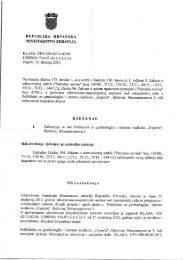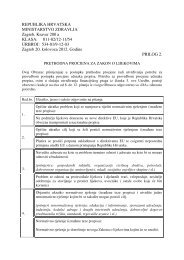studija o gmo vijeÄe za gmo 2013 - Ministarstvo zdravlja
studija o gmo vijeÄe za gmo 2013 - Ministarstvo zdravlja
studija o gmo vijeÄe za gmo 2013 - Ministarstvo zdravlja
You also want an ePaper? Increase the reach of your titles
YUMPU automatically turns print PDFs into web optimized ePapers that Google loves.
Mr.sc. Jagoda Munić, Zelena akcija, ZagrebUtjecaj GMO-a na prirodu i okolišDanas u komercijalnoj upotrebi postoje pretežno dvije vrste genetiski modificiranih usjeva.U prvu grupu spadaju oni koji su otporni na nametnike (kukce), jer su modificirani na načinda sadrže otrov u sebi, tj. sadrže gene bakterije tla Bacillus thuringiensis (Bt) koji stvarajutoksine <strong>za</strong> insekte.Druga dominirajuća vrsta su usjevi modificirani na način da su stekli otpornost na heribicide,tj. <strong>za</strong> razliku od okolnih biljaka (korova), mogu biti tretirani herbicidima bez posljedica. Ovavrsta modifikacije donosi dupli rizik <strong>za</strong> okoliš i prirodu, prvo kroz utjecaj pesticida na okoliš tekroz utjecaj samog GM usjeva na okoliš.Procjena negativnih utjecaja proizvodnje i korištenja GMO-a, nije jednostavna, jeristraživanja pod utjecajem različitih sektora daju različite rezultate, <strong>za</strong>hvaljujući različitimmetodološkim pristupima (oblikovanju hipoteze, veličini uzorka, te vremenskom rasponumjerenja) i različitim stupnjevima neovisnosti i sukoba interesa.Usjevi koji su otporni na kukce mogu biti toksični i <strong>za</strong> ostale kukce, na primjer <strong>za</strong> leptire, a nesamo <strong>za</strong> ciljane štetočine. Dogotrajna izloženost peludu GM kukuru<strong>za</strong>, s modifikacijomBacillus thuringiensis (Bt) toksina utječe na ponašanje 1 i preživljavanje 2 leptira monarhDanaus plexippus, najpoznatijeg sjevornoameričkog leptira. Utjecaj na europske leptire nijedovoljno poznat zbog nedovoljnog istraživanja. Ipak neka istraživanja otvaraju <strong>za</strong>brinutostzbog utjecaja na leptire 3 , 4 , 5 , 6 .GM Bt usjevi loše utječu 7 na kukce važne <strong>za</strong> prirodnu kontrolu štetočina na kukuruzu, kao štoje slučaj sa zlatookama (Chrysopidae). 8 , 9 , 10 , 11 . Primjećena je veća smrtnost u ranijem stadijurazvoja kod vrta zlatooke (Chrysoperla cornea) i dvotočkaste bubamare (Adalia bipunctata).1 Prasifka, P.L., Hellmich, R.L.P, rasifka, J.R. & Lewis, L.C. 2007E. ffects of Cry1Ab-expressing corn anthers on the movementof monarch butterfly larvae. Environ Entomolology 36:228-332 Dively, G.P., RoseR, ., Sears, M.K., Hellmich, R.LS. tanley-Horn, D.E. Calvin, D.D. Russo, J.M. & Anderson, P.L.. 2004. Effectson monarch butterfly larvae (Lepidoptera: Danaidae) after continuous exposure to Cry1Ab expressing corn during anthesis.Environmental Entomology 33: 1116-1125.3 Lang, A. & Vojtech, E. 2006. The effects of pollen consumption of transgenic Bt maize on the common swallowtail, Papiliomachaon L. (Lepidoptera, Papilionidae). Basic and Applied Ecology 7: 296—306.4 Darvas, B., Lauber, E., Polga´rL, . A., Peregovits, L., Ronkay, L., JuracsekJ.,, et al. (2004). Nontarget effects of DK-440-BTY(Yieldgard) Bt-corn. First Hungarian–Taiwanese entomological symposium, 11–12 October 2004, Budapest HungarianNational History Museum (p. 5).5 Felke, V.M. & Langenbruch, G.A. 2003. Effect of Bt-maize-pollen on caterpillars of Inachis io in a laboratory assay. GesundePflanzen, 55: 1-7.6 Felke, M., Lorenz, N. & Langenbruch, G-A. 2002. Laboratory studies on the effects of pollen from Bt-maize on larvae ofsome butterfly species. Journal of Applied Entomology 126: 320– 325.7 Obrist, L.B., Dutton, A., Romeis, J. & Bigler, F. 2006. Biological activiotyf Cry1Ab toxin expressed by Bt maize followingingestion by herbivorous arthropods and exposure of the predator Chrysoperla carnea. BioControl 51: 31-48.8 Andow, D.A. and A. Hilbeck. 2004. Science-based risk assessment for non-target effects of transgenic crops. Bioscience 54:637-649.9 Obrist, L.B., Dutton, A., Romeis, J. & Bigler, F. 2006. Biological activity of Cry1Ab toxin expressed by Bt maize followingingestion by herbivorous arthropods and exposure of the predator Chrysoperla carnea. BioControl 51: 31-48.10 Harwood, J.D., Wallin, W.G&. Obrycki, J.J. 2005. Uptake of Bt endotoxins by non-target herbivores and higher orderarthropod predators: molecular evidence from a transgenic corn agroecosystem. Molecular Ecology 14: 2815-2823.11 Lövei, G.L. & Arpaia, S. 2005.The impact of transgenic plants on natural enemies: a critical review of laboratory studies.Entomologia Experimentalis et Applicata 114: 1–14, 2005.


